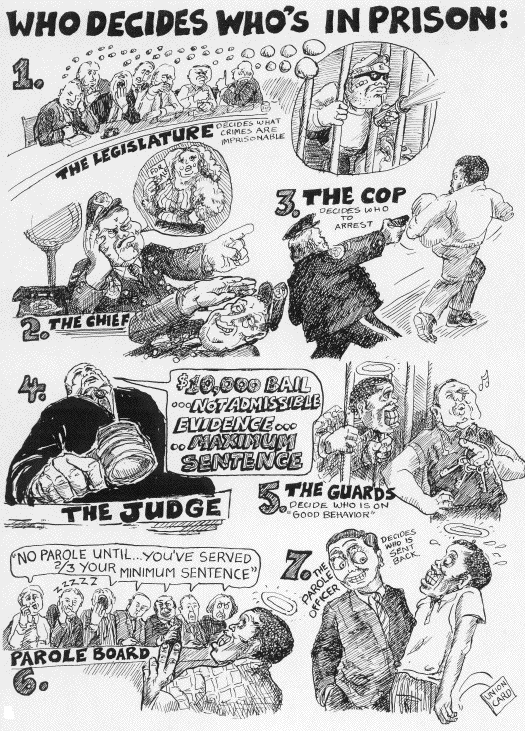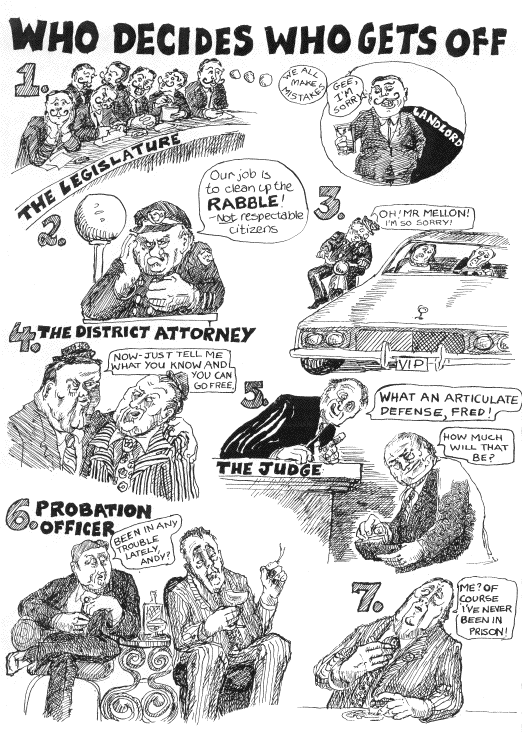Introduction
For more than three years the prisoners of Massachusetts have kept up a struggle to change the system which imprisons and exploits them. They have tried to teach the Massachusetts public what prisons really do to the men and women in them, why the system fails to stop crime, and why our prisons must be abolished.
This booklet was written to aid that struggle. To do that, it will explain how the system is run, who benefits from the system, and why prisons make the problems of crime, poverty and violence in our society worse and worse as years go by. It also will discuss several related issues, such as:
- Where the state Department of Correction spent the $38 million it got last year
- Why prisoners are almost always poor people who remain poor as a result of imprisonment
- Why the prison system helps no one except the people who run it -- not the taxpayers, not the victims of crime, and certainly not the prisoners.
Struggle for justice
In the last few years, prisoners have learned better than ever how to work together to do away with the system which has killed, driven insane or ruined the lives of so many of their brothers and sisters.
By early 1972, prisoners had achieved two major victories: the appointment of John 0. Boone as Commissioner of Correction, and the passage of the Omnibus Prison Reform Act of 1972, Chapter 777 of the General Laws. Boone's job was to implement the reforms promised in that legislation: programs such as furloughs, work release, education and community correctional centers. But these victories only marked a new phase in the struggle.
The guards' union opposed every attempt by Commissioner Boone to change the prison system. After 18 months on the job, the new commissioner was fired by Governor Francis W. Sargent, who gave up on his promise of prison reform rather than risk a political fight with the guards' union. Two years after Chapter 777, it is still necessary to force the prison wardens and guards to obey the new law.
For most prisoners, conditions are no better today than they were before passage of the new law. In some cases they are worse. The past two years have been a time of constant beatings, lockups, transfers and even murders. More than a dozen prisoners have died at Walpole, Norfolk and Bridgewater as a result of the guards' attempts to sabotage reform.
As this is written, the prisoners at Walpole are still trying to force the administration to implement the furlough program, begin serious educational programs, and pay prisoners a day's pay for a day's work. The National Prisoners' Reform Association (NPRA) has staged a successful strike for almost a year in an effort to improve conditions at Walpole. Although the NPRA is recognized by the Department of Correction, Supt. Douglas Vinzant has refused to begin serious negotiations. The strike continues despite the high price the men of Walpole have paid so far. But it would not be necessary for them to strike if the administration merely carried out the reforms promised by law two years ago.
Why we have prisons
Punishment, control and profit were the reasons for the creation of Massachusetts' first prisons: the jails and houses of correction that the Pilgrims and Puritans started putting up almost as soon as they got here.
Then as now, prisons were used to punish the poor and rarely anybody else but the poor. Since many crimes were punishable by hanging or other types of execution or torture, prisons were at first used mainly to punish minor offenses. The rich didn't go to prison since they were allowed to pay fines as punishment on the rare occasions when they were prosecuted.
In order to control the working-class population, a law passed in 1692 gave the government the power to lock up men and women found to "live idly and misspend their time in loitering." A 1699 law required every county to have a house of correction for "the Suppressing and Punishing of Rogues, Vagabonds, Common Beggars and Other Lewd, Idle and Disorderly Persons; and also for setting the poor to work." Prisons were used to keep new immigrants from simply living off the land instead of going to work at low wages for the merchants and large landowners who controlled the colonial government.
Each house of correction was equipped with workshops (prison industries), thus allowing the colony to profit from the hard labor forced on prisoners. Prisoner labor contributed to the Massachusetts economy from the start, while the threat of imprisonment was used to keep other citizens at work.
The foundations of modern-day capitalism in Massachusetts were literally built by prisoners from Charlestown State Prison. After building the prison themselves, in 1805, prisoners were put to work cutting and shaping granite from the Quincy quarries. This stone was used in many of the grand old buildings still standing in Boston's financial district and Haymarket Square. An 1828 report of the Massachusetts Senate states that the prison earned a net profit of $23,000 in the years 1824-26 as a result of the booming granite business.
The number of prisons in Massachusetts has changed over the years, but their function has not. Neither has the prison architecture. Except for plumbing and. electricity, Walpole prison is not much different from the Charlestown prison it replaced in 1956.

Who goes to prison
Our prisons are filled with men and women who could not earn a decent living by legal means and therefore tried illegal means. The wife of one Walpole prisoner summed up the reasons for his imprisonment this way:
"I had worked all during my pregnancy because my husband, being an ex-prisoner, couldn't find work. I had no prenatal care because we couldn't afford it. If I'd had it, perhaps the death of one of my twins could have been prevented. With the new baby, I could no longer work. My husband tried and tried to find work, but he found nothing day after day. He became so depressed, so desperate and so destitute that he attempted an armed robbery -- only to be shot, only to be taken away from us, only to be caged. But all he wanted to do was to take care of and feed us, and no one would give him a job." (The names of prisoners and families from whom information was obtained will usually not be given in this booklet, in order to protect them from reprisals from prison officials.)
Equally tragic stories sum up the situation of every prisoner. Most of the "crime in the streets" that the average citizen worries about has its roots in poverty, or else in the results of poverty such as alcoholism, gambling, family breakups, mental illness, or many years of frustration with poor schools, slum housing and low-paid jobs. Statistics tell the same story:
- Fifty-four percent of Massachusetts prisoners went no further than ninth grade. Only 17 percent graduated from high school.
- More than 60 percent come from the state's five major urban areas: Boston, Worcester, Springfield, New Bedford and Lowell.
- Seventy-five percent worked as manual laborers or service workers and less than 10 percent as businessmen or professionals.
In spite of their crimes, prisoners too are victims:
Victims of the Massachusetts economy, which guarantees that 7 or 8 percent of the workforce is unemployed and that many more are forced to live on salaries of $80, $90, or $100 a week.
Victims of Massachusetts government, which refuses to provide adequate housing and education for all of its citizens.

Victims of racism, which is why nearly half of the prison population is black or Puerto Rican. Lastly, prisoners are victims of the prison system itself, a system which guarantees that more than half of all prisoners will be imprisoned again after release, usually for a more serious offense. In fact, many prisoners are men and women who keep going back and forth through prison doors all of their lives:
- A third of Massachusetts prisoners did time in juvenile prisons.
- Half had been in county houses of correction for a previous offense.
- Nearly half had been in state or Federal prison before.
More often than not, prisoners are men and women doing "life on the installment plan" -- never able to break the cycle of poverty and imprisonment.
Massachusetts' two systems of justice
Our prisons are filled with the poor, but not because only the poor commit crimes. On the contrary, serious crime is a problem in every level of society. For every burglar who rips off a stereo system, there is a landlord who rips off a tenant for an equal amount in excess profits. For every bank robber who goes to prison, there is a bank executive embezzling funds who does not go to prison. Nationwide losses to bank robbery in 1965 were $21 million, while losses to embezzlement were at least $200 million. That was the conclusion of a Presidential Task Force on crime which said that crimes such as price-fixing, stock fraud and embezzlement cost the nation far more than well-known crimes such as burglary or robbery.
But it is almost always the poorer criminals who show up in court. Police and district attorneys spend their time on the crimes of the poor, such as prostitution, gambling or robbery, instead of on the crimes of the rich, such as bribery or fraudulent advertising. Phony home-repair schemes and high-interest loan companies milk poor and working-class people of millions every year, but they are seldom investigated. This is partly because business crimes are hard to investigate, but mostly because political strings are pulled to keep investigators away from the rich and the powerful.
In court, the dual system of justice is clearly visible. The more money a defendant has, the speedier is his or her trial and the less likely he or she is to get convicted. The poor, black or working-class defendant usually, has a public defender who has to take dozens of cases a day and does not have time to do a good job. The wealthier defendant can afford to hire full-time lawyers and expert witnesses. When sentencing occurs, the wealthy defendant is fined or put on probation, while the poorer defendant is likely to go to jail. That's why almost every crime may be punished with either a fine or imprisonment -- so that those who can afford to pay don't have to go away.
Even in murder cases, the punishment depends on who the defendant is. First degree murder carries a mandatory life sentence with no possibility of parole. Second degree murder also is punished by a life sentence, but with a possibility of parole after 15 years. Manslaughter carries no mandatory sentence. The prosecutor and the judge determine what is first degree murder, what is second degree murder and what is manslaughter. The outcome of that decision often depends on who is the defendant, not who was killed or how.
Of the 328,000 men and women convicted in Massachusetts district courts in 1971, only 11,000 were sentenced to imprisonment. That's one out of 30, or roughly three percent. Almost every person in that three percent was poor. Once in prison, they are almost certain to stay poor for the rest of their lives.
Finally, it is important to realize that in most cases the 29 out of 30 convicted persons who do not go to prison are little different from the ones who do. In fact, almost every citizen has at some time committed a prisonable offense -- such as drunken driving, tax evasion, assault and battery, larceny over $50, gambling or possession of marijuana. The real difference between most prisoners and most other people who have never been inside a courtroom is just a combination of money and luck. Mostly it's a matter of money.